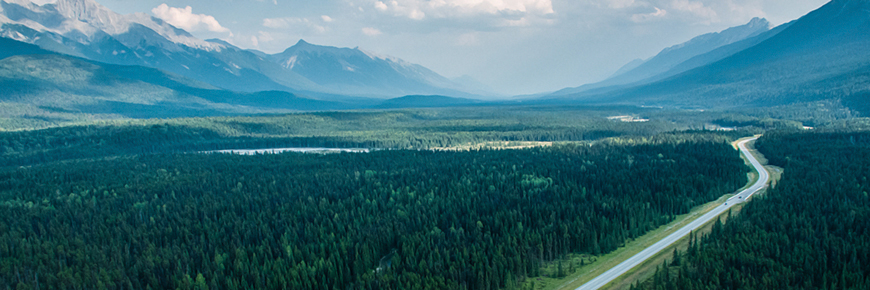
History of Highway 93 South
Kootenay National Park
Indigenous peoples traveled and stewarded the area now known as Kootenay National Park for thousands of years. In the 1800's, explorers and settlers came.
In 1858, Sir James Hector traveled through Vermilion Pass and noted that, in all his explorations, the pass was the best route for a wagon road. But it was not until the early 1900's that settlers, led by the Invermere businessman R. Randolph Bruce, began clamouring for a more direct route to markets in Banff and Calgary. This led to a meeting with the premier of British Columbia and a proposal to build a road via the Vermilion and Kootenay River valleys, crossing Vermilion Pass as Hector had recommended in 1858.
Construction from the Columbia Valley began in 1911 and for the first time there was a road to the hot springs. This early route made no attempt to enter the canyon, instead the new road followed an old pack trail around the defile. In the next few years, the road was pushed almost over Sinclair Pass, but lack of local funding and a raging conflict on the other side of the world brought work to a stop.
By 1919 the "War to End Wars" was over, but the road was far from complete. The province didn't have enough funds to finish the work, so a deal was made with the federal government. The Banff-Windermere Road Agreement stipulated that the federal government would build the highway in exchange for 5 miles (8 km) of land on either side of the road for a national park. The park became a reality in 1920, three years before the road was completed.
The building of the highway is an epic story. No massive road building equipment had yet been invented to help overcome the many substantial engineering problems. Sheer hard work by men and horses was the tool used to clear the forest and hack the highway from the stony mountainsides. The toughest section was through Sinclair Canyon. Men widened that narrow notch with pick axes, shovels and dynamite; they threw a wooden bridge over the creek and carved a single lane for vehicles. Today Sinclair Creek continues to slowly deepen its canyon but it works deep beneath the concrete of the modern highway.
Travelling the newly completed highway was an experience. One government publication of the 1920's praised the Banff-Windermere highway as an excellent road for drivers because "fear was practically eliminated." The trip down from Banff took an entire day by Model T (or "Tin Lizzies" as they were affectionately known). Without the benefit of independent suspension, travelers felt every bump of the road. Although many of the grades were steeper than they are today, the Tin Lizzies were up to it. As one old timer said "you just put her in gear and she'd go up anything."
Related links
- Date modified :